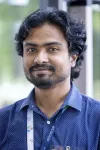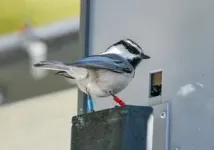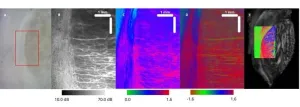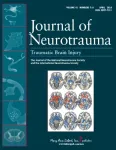“Before I joined his class, I was really not sure what I was going to do in life,” said Biswas, a postdoctoral research associate at Virginia Tech. “He revealed the beauty of science to me.”
Now, as the 2024 Jefferson Science Associates (JSA) Postdoctoral Prize winner, Biswas hopes to reveal a new method for the U.S. Department of Energy's Thomas Jefferson National Accelerator Facility to detect muons.
By themselves, muons aren’t actually that difficult for physicists to detect. They are a type of elementary particle that’s like a cousin to the electron. Some of the simplest detectors made are used routinely to detect muons in the cosmic radiation that streams through Earth’s atmosphere.
However, in the context Biswas is interested in, muons are much trickier to parse.
This context is a reaction known as double deeply virtual Compton scattering (DDVCS). In this reaction, an electron hits a proton target, and the end products are either a pair of electrons or a pair of muons. Detecting these particle pairs will tell scientists more about the internal structure of protons and neutrons, the building blocks of ordinary matter.
But to be able to study DDVCS with Jefferson Lab’s Continuous Electron Beam Accelerator Facility (CEBAF), Biswas will first have to figure out how to sift out muons from a sea of pions.
The pion problem
During these types of experiments, physicists can’t control which reactions occur between the electron and proton target. Many reactions other than DDVCS will take place, producing a huge background of pions, another type of particle.
“This pion background is the biggest obstacle to muon detection,” Biswas said.
Because of this pesky pion background, it would be simpler to study DDVCS by detecting the electron pairs that this reaction produces. It comes down to mass. Muons and pions have more similar masses; electrons and pions have less similar masses. This makes it easier for Hall C detectors to distinguish electrons and pions.
Unfortunately, this easier electron route isn’t an option at Jefferson Lab because there’s no way to tell apart CEBAF’s beam electrons from the signal electrons produced through DDVCS. So, to study this reaction, the lab’s researchers will have to traverse the trickier muon route. For his prize-winning project, “Detection of Muons for Studying Double Deeply Virtual Compton Scattering (DDVCS) in Hall C, JLab,” Biswas will figure out how to pick muons out of the pion background for future DDVCS experiments at Jefferson Lab.
The Jefferson Lab Users Organization (JLUO) Board of Directors has awarded the JSA Postdoctoral Prize since 2008. The group represents the scientists who come to Jefferson Lab to conduct research with its unique facilities, including the DOE user facility, CEBAF. The board judges each applicant on their record of accomplishment in physics, proposed use of the research grant, and the likelihood of further accomplishments in the Jefferson Lab research fields.
“It feels great. Of course, recognition feels good, but the main point is that my proposal got reviewed by many other peers in the field. It makes me feel like people see some value in my ideas. I think that’s the most important part for me,” Biswas said.
The grant is funded by the JSA Initiatives Fund program, which JSA provides to support programs, initiatives and activities that further the scientific outreach, and promote the science, education and technology missions of Jefferson Lab and benefit the laboratory’s user community.
A myriad of methods
Biswas plans to tackle muon detection from different angles to see which method, or methods, will work best.
“Because it’s a complicated process, I don’t predict one method will work by itself,” he said. “That’s why I want to bring different available methods together and see what works.”
Biswas will first simulate all possible reactions between the beam electrons and the proton target to understand which processes contribute to the pion background. Then, he’ll simulate and assess the viability of various techniques.
The first method he’ll test is a traditional particle identification method known as particle identification (PID), which has been used in Jefferson Lab’s Hall C for many experiments. PID can differentiate between electrons and pions, but Biswas is not sure if it will successfully detect muons by itself.
That’s why he’s also going to try another technique called pulse shape discrimination (PSD). PSD separates particles based on measuring details of the radiation signal they give off at the billionth of a second level. PSD can be cleaner than other PID methods, meaning less of the desired signal is discarded with the background. There’s no guarantee PSD will work in this context, though; it’s typically employed in lower energy experiments than those at Jefferson Lab and has not yet been tested in Hall C.
Biswas plans to supplement PID and PSD with machine learning techniques, but only time will tell if these methods will work on their own or in tandem to detect muons. The methods that do work will eventually be implemented in a muon detector prototype, which could aid experiments beyond DDVCS.
“If we can figure out muon detection in Hall C, it might be helpful for other experiments that want to detect muons,” Biswas said.
His findings may be applicable to forthcoming Electron-Ion Collider (EIC) experiments that are also on the hunt for muons.
“Whatever the findings are, we might extrapolate it to the EIC to determine if it will need a dedicated muon detector or if the existing detectors will do,” he said.
During this project, Biswas will work with Marie Boër at Virginia Tech, as well as Brad Sawatzky and Dave Gaskell at Jefferson Lab. As an undergraduate student, Keagan Bell from Virginia Tech helped Biswas lay the foundation for this project. Bell will continue working with Biswas.
Biswas plans to use the $10,000 JSA Postdoc Prize money to send Bell and himself to conferences to present their results, invest in computational facilities for their simulations, and organize a workshop focused on the detection of muons in medium energy and DDVCS experiments.
“I want to bring together experts from different labs and with diverse expertise so that we can share our results and discuss,” Biswas said.
He hopes uniting all these different people—and techniques—will make muon detection and the study of DDVCS possible at Jefferson Lab.
By Chris Patrick
-end-
Jefferson Science Associates, LLC, manages and operates the Thomas Jefferson National Accelerator Facility, or Jefferson Lab, for the U.S. Department of Energy's Office of Science. JSA is a wholly owned subsidiary of the Southeastern Universities Research Association, Inc. (SURA).
DOE’s Office of Science is the single largest supporter of basic research in the physical sciences in the United States and is working to address some of the most pressing challenges of our time. For more information, visit https://energy.gov/science
END




